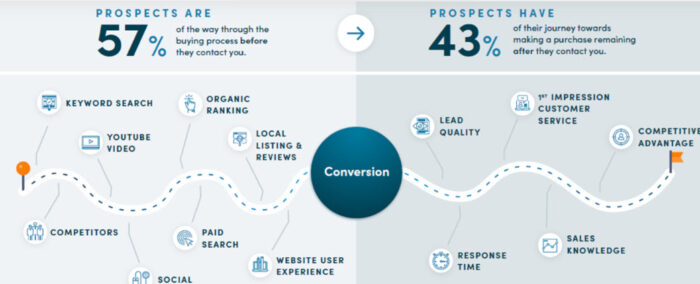April 27 2023
Three Ways Marketing Efforts Can Support Long, Industrial B2B Lead Cycles
Why B2B Lead Cycles are Longer than B2C
As consumers, we know the majority of B2C purchases work at an individual level and are completed within minutes, and often involve low-value items. The average B2B purchase involves six to ten decision makers‚ each armed with four or five pieces of information they’ve gathered independently, usually involving high-value investments, and can take months to complete. The more people in the mix, and the more research needed, the more time it takes to decide on the right solution. This is the long lead cycle.
No set time benchmarks long lead cycles, but these are measured from the first touch point to a deal’s close. The longer the cycle, the more touchpoints are needed to keep potential leads engaged and educated. Industrial lead cycles often fall into this category as solutions are complex and specific, meaning marketing strategy has to find a way to address these specifications so that multiple researchers find this information.
In this blog, we look at the long and winding road of the average industrial B2B lead and provide three essential tips for persistent, but not aggressive, marketing to help your business lead potential customers toward a purchase.
Is it a Lead Cycle or a Lead Maze?
The term lead cycle is very misleading as the path to purchase is no longer linear. Circular charts, line graphs or the classic sales funnel no longer make sense given customers can now come in from various channels and at various times.
To track this, Gartner broke down six B2B buying jobs that customers need to complete a final purchase, each branching off into other activities. Each job can be revisited, and the order can be more simultaneous than sequential given the number of individuals involved. The end result looks more like a maze, with more options to get to the cheese.

With so many options to get into the maze, you still need to ensure the right leads find their way inside. That’s why our first tip for a long, Industrial B2B lead cycle is a smarter search strategy.
Tip 1: Smarter Search Strategy
There’s a reason “I’ll Google it” is synonymous with research. Even for industrial B2B’s complex needs, a search engine is a key place for research. A methodology like B-SMART® used in TopSpot’s SEO and PPC strategies, takes a user’s mindset into account when choosing target keywords and content to ensure Clients show up early in the search engine results page or SERP. This approach weeds out unnecessary traffic and costly clicks to keep the path clear for purchase.
Today, the search landscape is busier, and to stand out from competitors, having multiple elements within a SERP is an advantage. Using an integrated approach that combines SEO, PPC, video, and helpful content to populate “People Also Ask” features means your solution shows up in more ways to more people.
With all the right researchers coming into the maze, you now need to encourage them through it as they navigate options and meet internally. This is where a customer service mindset will help.
Tip 2: Customer Service Counts
What B2B has over B2C is ample time to build relationships with leads to make them lasting customers through repeat business and referrals. A customer service mindset should be present at any touchpoint. This means using this extra time to educate and personalize marketing from social posts to follow-up calls.
Most B2B companies reach out to multiple vendors when doing research, so once you get their attention, you must be nurturing their journey with helpful and educational content. On your website and landing page, be sure you are offering white papers, process or facility tour videos, and other information they can share with their team to get all their questions answered.
Remember, 57% of the buying process happens in the search space, but there’s a substantial amount of travel time left. Once all the information from search and your landing pages has been acquired, the next step is contact.

To get leads to the center of the maze, it is important to make sure in-person meetings, email exchanges, and phone calls are top-notch. This is where sales and marketing alignment is critical, and you can find tips to strengthen that alignment here.
Trust is fundamental for long sales cycles as businesses must be able to advise and ensure the time and investment are worth it. That’s why our last tip, mapping out the maze with tools like CallRail and LOOP can help close future leads faster.
Tip 3: Mapping the Maze
If we’re talking about a lead maze, then tracking who does what where is essential to capitalizing on opportunities and seeing what draws in leads. Prioritizing data analytics and user behavior, then adjusting your content and strategy will help ensure leads don’t get lost.
TopSpot uses a toolset of LOOP Analytics, which looks at form submissions and user behavior to understand lead quality, and CallRail, which provides call tracking and gathers trends to help inform marketing and customer service efforts.
Remember, 59% of B2B companies get a quote from three to five different businesses when searching for a new vendor or supplier. That’s a lot of mazes, but if yours is mapped and optimized, then the path is far easier to manage than your competitors.
Do You Have the Right Strategy and Tools for Long Lead Cycles?
Now that you have the tips to navigate leads through the long and winding road of industrial B2B purchasing, your marketing and sales team can approach the lead maze with smarter search strategies, a focus on customer service throughout the maze, and track the right activity with analytics that can ease future journeys.
Don’t have these strategies and tools in place? Contact TopSpot to learn more about navigating quality leads with a Team that works as an extension of your business.

